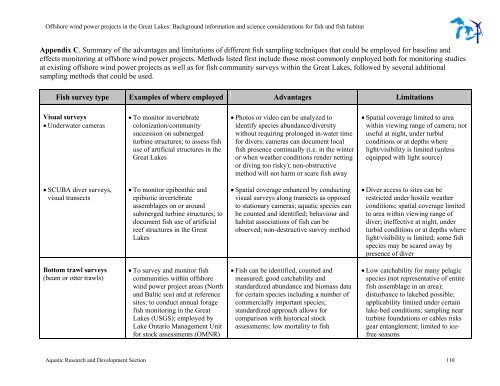Offshore Wind Power Projects in the Great Lakes - Ministry of ...
Offshore Wind Power Projects in the Great Lakes - Ministry of ...
Offshore Wind Power Projects in the Great Lakes - Ministry of ...
Create successful ePaper yourself
Turn your PDF publications into a flip-book with our unique Google optimized e-Paper software.
<strong>Offshore</strong> w<strong>in</strong>d power projects <strong>in</strong> <strong>the</strong> <strong>Great</strong> <strong>Lakes</strong>: Background <strong>in</strong>formation and science considerations for fish and fish habitat<br />
Appendix C. Summary <strong>of</strong> <strong>the</strong> advantages and limitations <strong>of</strong> different fish sampl<strong>in</strong>g techniques that could be employed for basel<strong>in</strong>e and<br />
effects monitor<strong>in</strong>g at <strong>of</strong>fshore w<strong>in</strong>d power projects. Methods listed first <strong>in</strong>clude those most commonly employed both for monitor<strong>in</strong>g studies<br />
at exist<strong>in</strong>g <strong>of</strong>fshore w<strong>in</strong>d power projects as well as for fish community surveys with<strong>in</strong> <strong>the</strong> <strong>Great</strong> <strong>Lakes</strong>, followed by several additional<br />
sampl<strong>in</strong>g methods that could be used.<br />
Fish survey type Examples <strong>of</strong> where employed Advantages Limitations<br />
Visual surveys<br />
• Underwater cameras<br />
• SCUBA diver surveys,<br />
visual transects<br />
Bottom trawl surveys<br />
(beam or otter trawls)<br />
• To monitor <strong>in</strong>vertebrate<br />
colonization/community<br />
succession on submerged<br />
turb<strong>in</strong>e structures; to assess fish<br />
use <strong>of</strong> artificial structures <strong>in</strong> <strong>the</strong><br />
<strong>Great</strong> <strong>Lakes</strong><br />
• To monitor epibenthic and<br />
epibiotic <strong>in</strong>vertebrate<br />
assemblages on or around<br />
submerged turb<strong>in</strong>e structures; to<br />
document fish use <strong>of</strong> artificial<br />
reef structures <strong>in</strong> <strong>the</strong> <strong>Great</strong><br />
<strong>Lakes</strong><br />
• To survey and monitor fish<br />
communities with<strong>in</strong> <strong>of</strong>fshore<br />
w<strong>in</strong>d power project areas (North<br />
and Baltic sea) and at reference<br />
sites; to conduct annual forage<br />
fish monitor<strong>in</strong>g <strong>in</strong> <strong>the</strong> <strong>Great</strong><br />
<strong>Lakes</strong> (USGS); employed by<br />
Lake Ontario Management Unit<br />
for stock assessments (OMNR)<br />
• Photos or video can be analyzed to<br />
identify species abundance/diversity<br />
without requir<strong>in</strong>g prolonged <strong>in</strong>-water time<br />
for divers; cameras can document local<br />
fish presence cont<strong>in</strong>ually (i.e. <strong>in</strong> <strong>the</strong> w<strong>in</strong>ter<br />
or when wea<strong>the</strong>r conditions render nett<strong>in</strong>g<br />
or div<strong>in</strong>g too risky); non-obstructive<br />
method will not harm or scare fish away<br />
• Spatial coverage enhanced by conduct<strong>in</strong>g<br />
visual surveys along transects as opposed<br />
to stationary cameras; aquatic species can<br />
be counted and identified; behaviour and<br />
habitat associations <strong>of</strong> fish can be<br />
observed; non-destructive survey method<br />
• Fish can be identified, counted and<br />
measured; good catchability and<br />
standardized abundance and biomass data<br />
for certa<strong>in</strong> species <strong>in</strong>clud<strong>in</strong>g a number <strong>of</strong><br />
commercially important species;<br />
standardized approach allows for<br />
comparison with historical stock<br />
assessments; low mortality to fish<br />
• Spatial coverage limited to area<br />
with<strong>in</strong> view<strong>in</strong>g range <strong>of</strong> camera; not<br />
useful at night, under turbid<br />
conditions or at depths where<br />
light/visibility is limited (unless<br />
equipped with light source)<br />
• Diver access to sites can be<br />
restricted under hostile wea<strong>the</strong>r<br />
conditions; spatial coverage limited<br />
to area with<strong>in</strong> view<strong>in</strong>g range <strong>of</strong><br />
diver; <strong>in</strong>effective at night, under<br />
turbid conditions or at depths where<br />
light/visibility is limited; some fish<br />
species may be scared away by<br />
presence <strong>of</strong> diver<br />
• Low catchability for many pelagic<br />
species (not representative <strong>of</strong> entire<br />
fish assemblage <strong>in</strong> an area);<br />
disturbance to lakebed possible;<br />
applicability limited under certa<strong>in</strong><br />
lake-bed conditions; sampl<strong>in</strong>g near<br />
turb<strong>in</strong>e foundations or cables risks<br />
gear entanglement; limited to icefree<br />
seasons<br />
Aquatic Research and Development Section 110
















